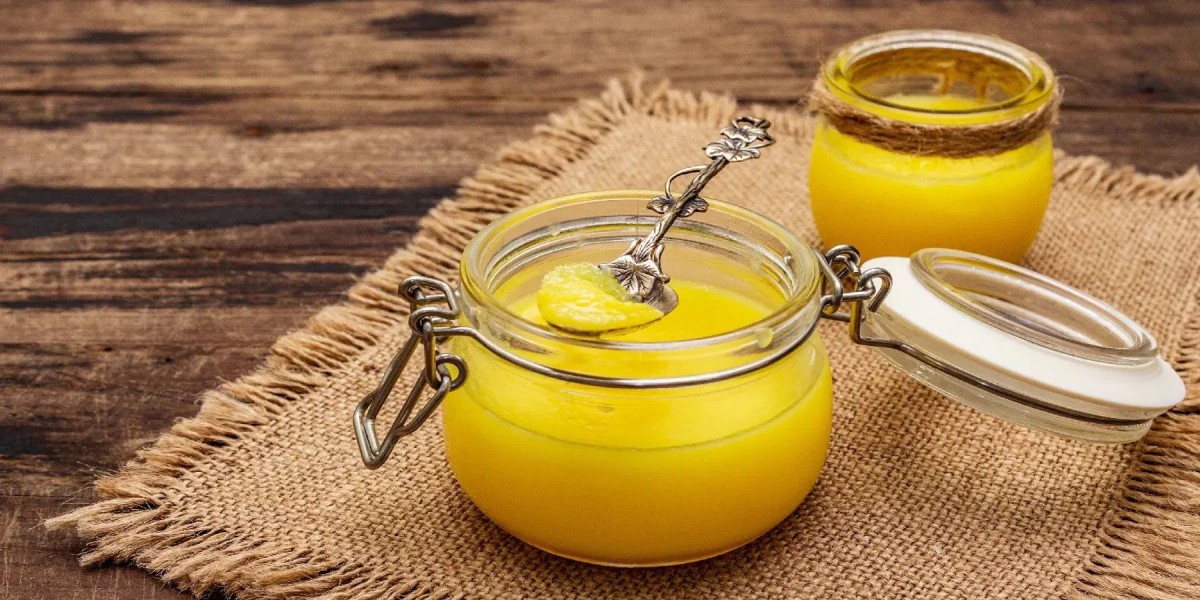Desi ghee, a form of clarified butter deeply rooted in Indian culinary traditions, has gained global attention for its rich flavor and potential health benefits. Made by simmering butter to separate the milk solids and water, leaving behind pure butterfat, desi ghee is prized for its high smoke point, nutty aroma, and versatility in cooking. Beyond its culinary appeal, desi ghee is celebrated in Ayurveda for its medicinal properties. This blog post explores the science-backed health benefits of desi ghee, its nutritional profile, and how it can be incorporated into a balanced diet.
What is Desi Ghee?
Desi ghee is traditionally prepared by churning curd (yogurt) into butter and then heating it to produce clarified butter. This process removes lactose, casein, and other milk solids, making it suitable for those with dairy sensitivities. The result is a golden, aromatic fat that is shelf-stable and packed with nutrients. Unlike regular butter, ghee is free from water content, which enhances its longevity and makes it ideal for high-heat cooking.
In Ayurveda, desi ghee is considered a sattvic food, promoting positivity, clarity, and nourishment. It is used not only in cooking but also in rituals, skincare, and medicinal preparations. Modern science is now catching up, validating many of ghee’s traditional claims through research.
Nutritional Profile of Desi Ghee
Desi ghee is a calorie-dense food, with approximately 112 calories per tablespoon. It is composed primarily of fats, including saturated fats, monounsaturated fats, and small amounts of polyunsaturated fats. Here’s a breakdown of its key components:
Saturated Fats: About 60% of ghee’s fat content is saturated, providing a stable energy source.
Monounsaturated Fats: These heart-healthy fats make up roughly 30% of ghee.
Butyric Acid: A short-chain fatty acid with anti-inflammatory and gut-health benefits.
Fat-Soluble Vitamins: Ghee is rich in vitamins A, D, E, and K, essential for immunity, bone health, and skin vitality.
Conjugated Linoleic Acid (CLA): A fatty acid linked to weight management and anti-cancer properties.
Cholesterol: Ghee contains cholesterol, but its impact on heart health is nuanced, as discussed later.
Ghee is also free from trans fats and artificial additives, making it a natural, minimally processed fat.
Health Benefits of Desi Ghee
1. Supports Digestive Health
Desi ghee is a rich source of butyric acid, a short-chain fatty acid that nourishes the cells lining the colon. Butyric acid reduces inflammation in the gut, promotes healthy digestion, and may help manage conditions like irritable bowel syndrome (IBS) and Crohn’s disease. It also supports the growth of beneficial gut bacteria, fostering a balanced microbiome.
Ghee stimulates the secretion of digestive enzymes, aiding in the breakdown of food and nutrient absorption. In Ayurveda, consuming a teaspoon of ghee on an empty stomach is believed to improve digestion and alleviate bloating or constipation.
2. Boosts Immunity
The fat-soluble vitamins in desi ghee, particularly vitamins A and D, play a crucial role in immune function. Vitamin A supports the production of white blood cells, which fight infections, while vitamin D enhances the body’s ability to combat pathogens. Ghee’s antioxidant properties, derived from vitamin E, help neutralize free radicals, reducing oxidative stress and supporting overall immunity.
In traditional practices, ghee is combined with herbs like turmeric or ashwagandha to create immune-boosting remedies. Its nourishing qualities make it a staple in postpartum diets to aid recovery and strengthen the body.
3. Promotes Heart Health (When Used in Moderation)
While ghee is high in saturated fat, recent research suggests that moderate consumption may not harm heart health as previously thought. The saturated fats in ghee are primarily medium-chain triglycerides (MCTs), which are metabolized differently than long-chain fats and provide quick energy without significantly raising LDL (bad) cholesterol levels.
Ghee’s monounsaturated fats and CLA may also support cardiovascular health by reducing inflammation and improving lipid profiles. However, portion control is key, as excessive consumption of any fat can lead to weight gain and increased cardiovascular risk. The American Heart Association recommends limiting saturated fat intake to 5-6% of daily calories, so a tablespoon or two of ghee daily can fit into a balanced diet.
4. Enhances Skin and Hair Health
Desi ghee is a natural moisturizer, rich in fatty acids and vitamins that nourish the skin. When applied topically, it hydrates dry skin, reduces inflammation, and promotes wound healing. In Ayurveda, ghee is used in face masks and ointments to treat burns, scars, and eczema.
Internally, ghee’s vitamins A and E support collagen production and protect skin from environmental damage. For hair, massaging warm ghee into the scalp can strengthen roots, reduce dandruff, and add shine. Its emollient properties make it a popular ingredient in natural beauty products.
5. Aids Weight Management
Contrary to the belief that ghee causes weight gain, moderate consumption may support weight loss. The MCTs in ghee are quickly metabolized by the liver, providing energy and increasing satiety, which can reduce overeating. CLA in ghee has been linked to fat loss and improved body composition in some studies.
Ghee’s rich flavor also enhances the taste of meals, making it easier to enjoy nutrient-dense, low-calorie foods like vegetables. Replacing processed oils with ghee in cooking can reduce reliance on unhealthy fats, supporting a balanced diet.
6. Supports Bone Health
Desi ghee is a natural source of vitamin K2, which plays a vital role in calcium metabolism. Vitamin K2 directs calcium to the bones and teeth, preventing it from depositing in arteries and soft tissues. This reduces the risk of osteoporosis and arterial calcification. Ghee’s vitamin D content also enhances calcium absorption, further supporting skeletal health.
Incorporating ghee into meals with calcium-rich foods, such as leafy greens or dairy, can maximize its bone-strengthening benefits.
7. Improves Cognitive Function
The healthy fats in desi ghee provide a steady source of energy for the brain, which is composed of nearly 60% fat. DHA (docosahexaenoic acid), a type of omega-3 fatty acid found in small amounts in ghee, supports brain health and cognitive function. Ghee’s anti-inflammatory properties may also protect against neurodegenerative diseases like Alzheimer’s.
In Ayurveda, ghee is considered a medhya food, meaning it enhances intellect and memory. It is often used in preparations like Brahmi ghee to boost mental clarity and focus.
8. Lactose-Free and Suitable for Dairy Sensitivities
Since desi ghee is free from lactose and casein, it is well-tolerated by most people with dairy allergies or lactose intolerance. This makes it a versatile fat for those who cannot consume butter or other dairy products. However, individuals with severe dairy allergies should consult a healthcare provider before trying ghee.
9. High Smoke Point for Healthy Cooking
Desi ghee has a high smoke point of around 450°F (230°C), making it ideal for frying, sautéing, and roasting. Unlike oils that break down and release harmful free radicals at high temperatures, ghee remains stable, preserving its nutritional integrity. This makes it a healthier alternative to refined vegetable oils and margarine.
10. Supports Ayurvedic Healing
In Ayurveda, desi ghee is used as a carrier for herbs, enhancing their absorption in the body. It is a key ingredient in panchakarma (detoxification therapy) and is believed to balance the doshas (Vata, Pitta, and Kapha). Ghee is also used in nasya (nasal therapy) to improve respiratory health and in basti (enema therapy) to cleanse the colon.
How to Incorporate Desi Ghee into Your Diet
To reap the benefits of desi ghee, consume it in moderation as part of a balanced diet. Here are some practical ways to include it:
Cooking: Use ghee for sautéing vegetables, roasting spices, or frying eggs. Its rich flavor enhances both Indian and Western dishes.
Spread: Spread a thin layer of ghee on toast or rotis for a nutrient boost.
Baking: Substitute ghee for butter in cakes, cookies, and pastries for a nutty flavor.
Beverages: Add a teaspoon of ghee to warm milk or herbal tea for a soothing drink.
Ayurvedic Recipes: Prepare traditional dishes like khichdi or halwa with ghee for added nourishment.
Aim for 1-2 tablespoons of ghee daily, depending on your caloric needs and activity level. Choose high-quality, organic, or grass-fed ghee for maximum nutritional benefits.
Precautions and Considerations
While desi ghee offers numerous health benefits, it is not a cure-all. Excessive consumption can lead to weight gain and elevated cholesterol levels, particularly in individuals with pre-existing heart conditions. Those with obesity, diabetes, or cardiovascular issues should consult a healthcare professional before increasing ghee intake.
Additionally, not all ghee is created equal. Commercial ghee may contain additives or be made from low-quality butter. Opt for homemade or artisanal ghee from trusted sources to ensure purity and nutritional value.
Conclusion
Desi ghee is more than just a cooking fat; it is a nutritional powerhouse with a wide range of health benefits. From supporting digestion and immunity to promoting heart, skin, and bone health, ghee’s unique composition makes it a valuable addition to a balanced diet. Its versatility in cooking and deep roots in Ayurvedic traditions further enhance its appeal.
By consuming desi ghee in moderation and choosing high-quality sources, you can harness its benefits while enjoying its rich, nutty flavor. Whether you’re drizzling it over a warm bowl of dal or using it in a face mask, desi ghee is a timeless ingredient that bridges tradition and modern wellness.










